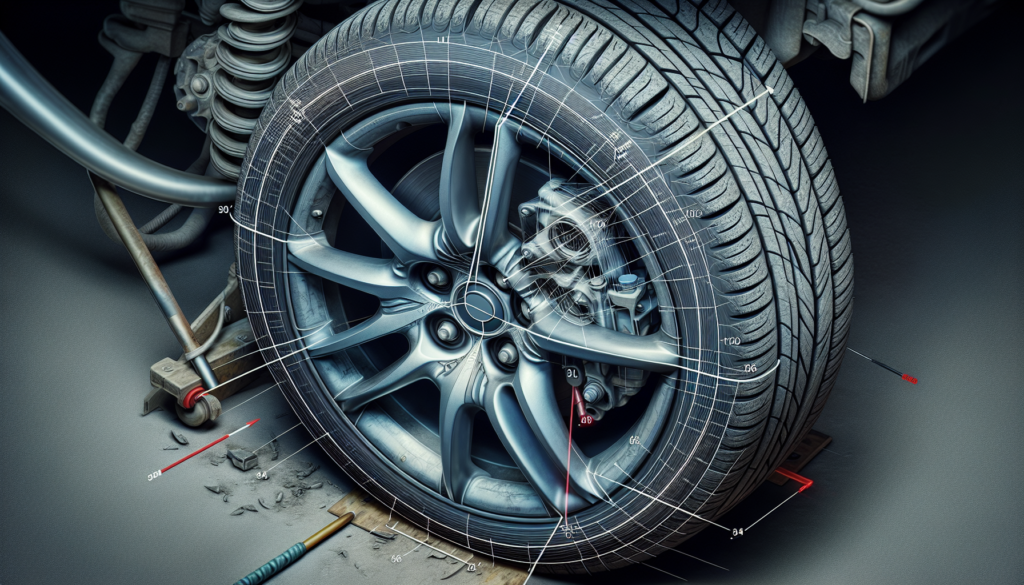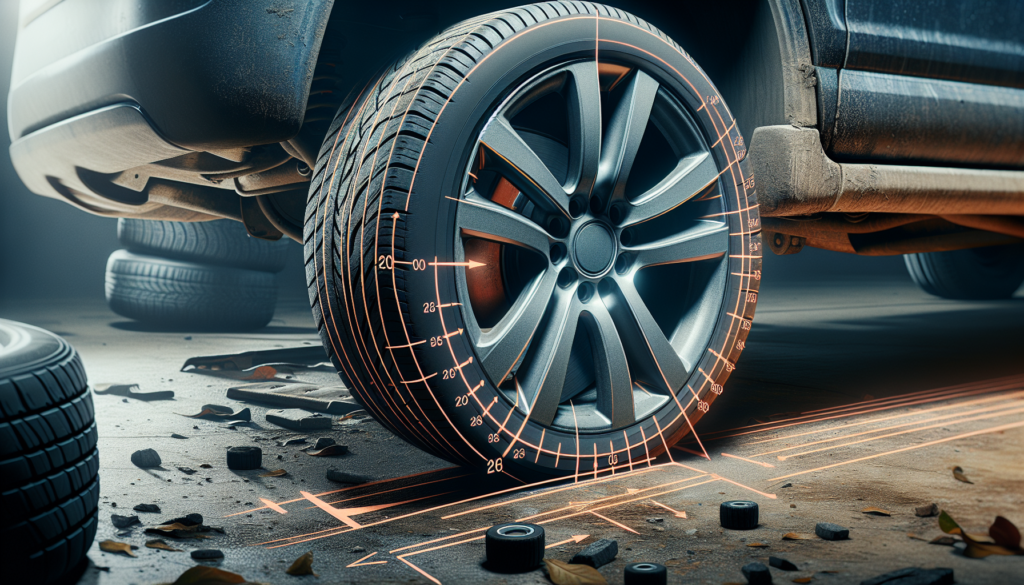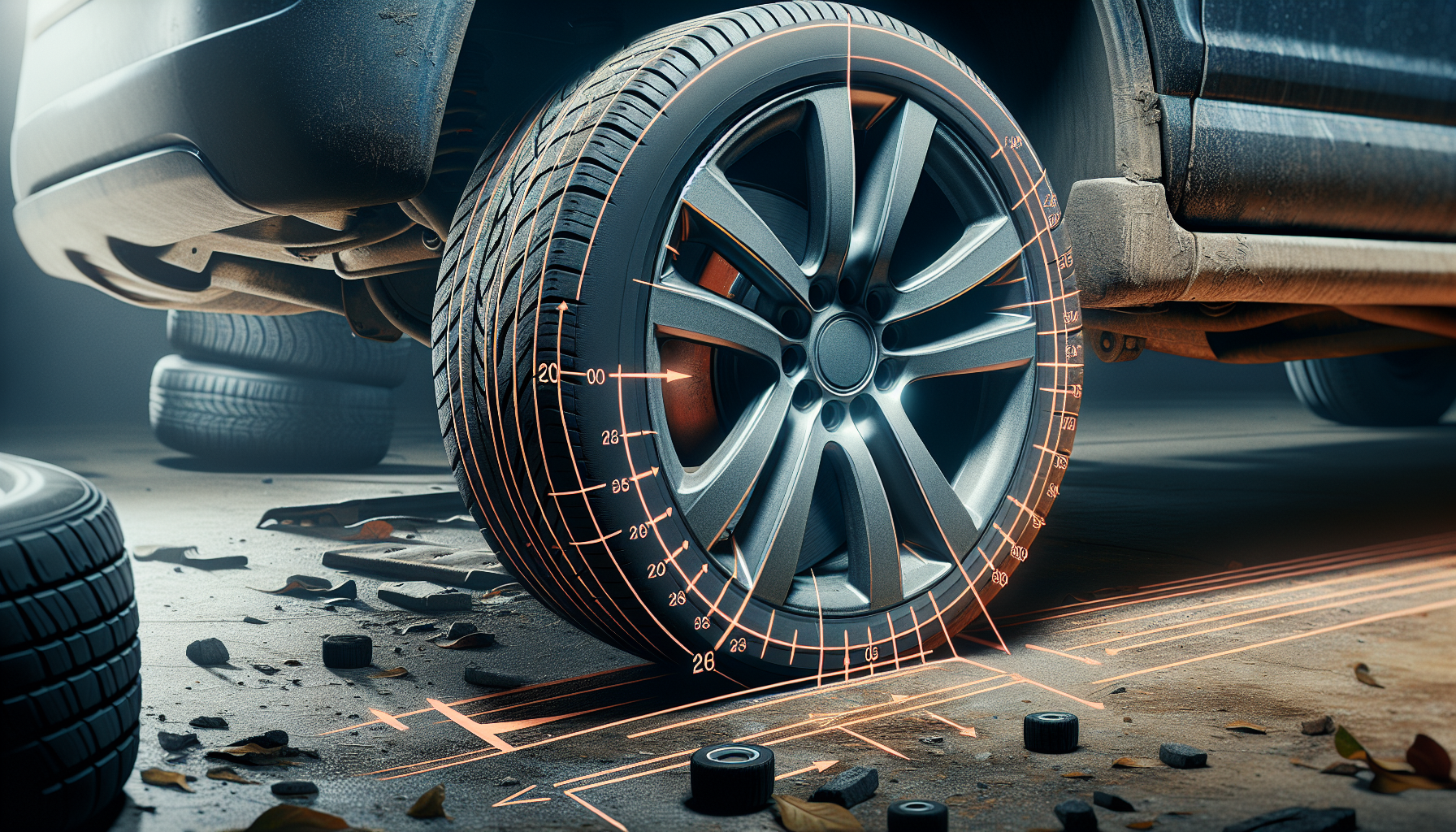Imagine driving down the road, the wind in your hair and the open road ahead. But suddenly, you notice a slight pull to one side as you try to steer your car straight. The question arises – can wheel alignment issues cause steering problems? Well, the answer is not so straightforward. While wheel alignment problems can indeed lead to steering issues, it’s crucial to understand the complex relationship between the two. In this article, we will explore how an imbalanced alignment can affect your steering, and provide valuable insights into why it’s essential to address this issue promptly. So, buckle up and let’s dive into the world of wheel alignment and steering!
Understanding Wheel Alignment
Definition of wheel alignment
Wheel alignment refers to the adjustment of the angles at which the wheels of a vehicle make contact with the road surface. It involves aligning the wheels to ensure they are parallel to each other and perpendicular to the ground. Proper wheel alignment is crucial for ensuring optimal vehicle handling, stability, and tire longevity.
Importance of proper wheel alignment
Having proper wheel alignment is essential for several reasons. Firstly, it promotes even and extended tire tread life, reducing the need for premature tire replacements. Secondly, it enhances steering response and control, allowing you to maneuver your vehicle more smoothly and safely. Additionally, correct wheel alignment helps maximize fuel efficiency, as misaligned wheels can result in increased rolling resistance. Overall, investing in regular wheel alignment maintenance ensures a more comfortable, reliable, and cost-effective driving experience.
Symptoms of misaligned wheels
Misaligned wheels can manifest in various symptoms that may indicate the need for alignment adjustment. One common sign is the vehicle pulling or drifting to one side while driving on a straight road. This occurs when the wheels are not properly aligned and can compromise your ability to maintain a straight path. Another symptom is steering wheel vibration or shimmying, which can be felt through the steering wheel while driving. Uneven tire wear is another red flag, as misaligned wheels can cause certain areas of the tires to wear down faster than others. Additionally, difficulty in steering or an off-center steering wheel are signs that the wheels may be misaligned.
Effect of Wheel Alignment on Steering
How wheel alignment affects steering
Wheel alignment plays a significant role in the overall steering performance of a vehicle. When the wheels are correctly aligned, the tires make optimum contact with the road surface, allowing for precise steering input. However, when the wheels are misaligned, the vehicle’s ability to respond to steering commands is compromised. Misaligned wheels can result in inconsistent and unpredictable steering behavior, making it challenging to maintain control of the vehicle.
Relationship between wheel alignment and steering performance
Proper wheel alignment directly influences steering performance. When the wheels are aligned correctly, the steering response is quick, smooth, and predictable. This enhances your ability to navigate corners, change lanes, and avoid obstacles. On the other hand, misaligned wheels can lead to steering instability, making it difficult to maintain a straight course and increasing the risk of accidents or collisions.
Steering problems caused by wheel misalignment
Misaligned wheels can contribute to various steering problems that affect the overall driving experience. One common issue is excessive pulling or drifting to one side, which requires constant correction to keep the vehicle on the intended path. Steering wheel vibration or shimmy can also arise from misaligned wheels, resulting in a shaky and uncomfortable driving experience. Moreover, difficulty in steering, such as a stiff or unresponsive steering wheel, can be attributed to wheel misalignment. Lastly, an off-center steering wheel, where it is not straight when driving straight, is another indication of alignment problems.

Types of Steering Problems
Pulling to one side
One common steering problem caused by wheel alignment issues is pulling to one side. This occurs when the wheels are misaligned, causing one or more tires to exert more force than the others. As a result, the vehicle tends to steer towards the side with the higher force, requiring constant correction to maintain a straight path.
Steering wheel vibration
Misaligned wheels can also lead to steering wheel vibration or shimmy. This vibration is often felt through the steering wheel and can vary in intensity depending on the severity of the misalignment. Not only is this uncomfortable for the driver, but it can also indicate the need for immediate wheel alignment adjustment.
Uneven tire wear
When the wheels are not properly aligned, it can result in uneven tire wear. Misaligned wheels can cause certain areas of the tires to make more contact with the road surface, leading to uneven wear patterns. This not only reduces the lifespan of the tires but also compromises vehicle safety and handling.
Difficulty in steering
Wheel misalignment can make steering more challenging and less responsive. The misaligned wheels can create resistance against steering inputs, making it harder to turn the steering wheel. This can impact precise maneuvering, especially in critical situations where quick steering response is required.
Off-center steering wheel
A noticeable sign of wheel misalignment is an off-center steering wheel. When the wheels are aligned correctly, the steering wheel should be centered when the vehicle is traveling straight. However, misaligned wheels can cause the steering wheel to be off-center, even when driving on a straight road. This misalignment not only affects the aesthetic appeal but can also indicate potential steering and alignment issues.
Causes of Wheel Alignment Issues
Impact with potholes or curbs
One of the primary causes of wheel alignment issues is the impact of potholes or curbs. Hitting a pothole or a curb with significant force can throw off the alignment of the wheels, affecting their angles and positioning. Even seemingly minor impacts can result in misalignment over time, so it is important to be cautious and avoid such collisions whenever possible.
Worn suspension components
Worn suspension components can also contribute to wheel alignment problems. Suspension parts, such as control arms, struts, or bushings, can wear out over time due to normal wear and tear. When these components deteriorate, they can cause the wheels to shift out of alignment, resulting in steering issues and uneven tire wear.
Improper installation of suspension parts
If suspension parts are not installed correctly, it can lead to wheel alignment issues. Improper installation can result in incorrect positioning or angles of the wheels, affecting their alignment. It is crucial to ensure that suspension components are installed by qualified professionals to avoid alignment problems.
Tire wear and rotation
Neglecting regular tire maintenance, such as proper inflation and rotation, can contribute to wheel alignment issues. Uneven tire wear, caused by neglecting rotation or alignment checks, can lead to misalignment over time. To prevent such issues, it is important to adhere to recommended tire maintenance practices and have regular alignment checks.
Accidents or collisions
Accidents or collisions, especially those involving the front or rear suspension, can cause significant wheel alignment problems. The impact from a collision can force the wheels out of their proper alignment, affecting steering performance and tire wear. After an accident or collision, it is crucial to have the alignment checked and corrected, if necessary, to ensure the vehicle is safe to drive.

Diagnostic Process for Wheel Alignment Issues
Visual inspection of tires and suspension components
The diagnostic process for wheel alignment issues starts with a visual inspection of the tires and suspension components. A qualified technician will examine the tires for signs of abnormal wear patterns, such as cupping, feathering, or uneven tread depth. They will also inspect the suspension components for any visible damage or wear that may affect wheel alignment.
Use of wheel alignment equipment
To accurately diagnose wheel alignment problems, specialized wheel alignment equipment is utilized. This equipment includes alignment racks, sensors, and computerized systems that measure the angles and positions of the wheels. By using this equipment, technicians can quantify and identify any misalignment in the vehicle’s wheel geometry.
Measurement and adjustment of wheel angles
Based on the measurements obtained from the alignment equipment, technicians can determine the specific wheel angles that need adjustment. Common angles that are evaluated include camber, toe, and caster. These angles are adjusted using specialized tools and equipment to bring the wheels back to their proper alignment according to the manufacturer’s specifications.
Testing steering response
After the wheel alignment has been adjusted, technicians perform a steering response test to ensure that the steering system is functioning correctly. This test allows them to evaluate the effectiveness of the alignment adjustments and confirm that the steering response has improved. By ensuring proper steering response, technicians can verify that the wheel alignment issues have been effectively addressed.
Signs of Wheel Alignment Problems
Uneven or abnormal tire wear
One of the most noticeable signs of wheel alignment problems is uneven or abnormal tire wear. Misaligned wheels can cause specific areas of the tires to wear down faster than others, resulting in cupping, scalloping, or feathering patterns. Regularly inspecting the tires for any signs of uneven wear is important to catch alignment issues early and prevent further damage.
Vehicle drifting or pulling to one side
If you find that your vehicle tends to drift or pull to one side while driving on a straight road, it may indicate wheel alignment problems. Misaligned wheels can cause the vehicle to veer off its intended path, requiring constant steering input to correct the drift. It is crucial to have the alignment checked and corrected promptly to ensure safe and stable driving.
Steering wheel not centered
While driving on a straight road, the steering wheel should be centered and level. If you notice that your steering wheel is off-center, it may suggest wheel alignment issues. When the wheels are misaligned, the steering wheel can deviate from its proper center position, even when driving straight. This misalignment can be a sign of other steering or alignment problems that should be addressed promptly.
Steering wheel vibration or shimmy
Another sign of wheel alignment problems is steering wheel vibration or shimmy. Misaligned wheels can cause the steering wheel to vibrate or shake, especially at higher speeds. This vibration can be felt through the steering wheel, making for an uncomfortable and potentially unsafe driving experience. If you experience steering wheel vibration, it is important to have the alignment checked and corrected as soon as possible.
Difficulty in steering
When the wheels are misaligned, it can make steering more difficult and less responsive. Wheel misalignment can cause resistance against steering inputs, making it harder to turn the steering wheel smoothly. If you find it increasingly challenging to steer your vehicle or notice a decrease in steering responsiveness, it may indicate the need for a wheel alignment adjustment.

Consequences of Ignoring Wheel Alignment Issues
Increased tire wear
Ignoring wheel alignment issues can lead to increased tire wear. Misaligned wheels can cause certain areas of the tires to make more contact with the road surface, resulting in faster and uneven tread wear. This premature tire wear not only reduces tire lifespan but also necessitates more frequent and costly tire replacements.
Reduced fuel efficiency
Misaligned wheels can negatively impact fuel efficiency. When the wheels are not aligned correctly, they can create increased rolling resistance. This means the engine has to work harder to move the vehicle, leading to decreased fuel efficiency. By regularly maintaining proper wheel alignment, you can maximize your vehicle’s fuel economy and save on fuel costs in the long run.
Decreased handling and control
Wheel alignment problems can significantly reduce the handling and control of your vehicle. Misaligned wheels can result in unpredictable steering behavior, making it difficult to maintain control, especially in emergency situations. This compromised handling can lead to safety risks and increase the likelihood of accidents or collisions.
Safety risks
Ignoring wheel alignment issues can pose significant safety risks. Misaligned wheels can affect the vehicle’s stability, steering response, and overall handling. This can compromise your ability to safely maneuver the vehicle, especially during sudden maneuvers or adverse road conditions. Addressing alignment problems promptly is crucial for ensuring road safety for yourself and other road users.
Costly repairs
Failing to address wheel alignment issues can lead to more extensive and costly repairs down the line. Misalignment can put additional stress on various components of the suspension and steering system, leading to premature wear and potential damage. By regularly maintaining proper wheel alignment, you can prevent unnecessary repairs and extend the lifespan of your vehicle’s components.
Wheel Alignment Correction Methods
Adjustment of wheel angles
The primary method for correcting wheel alignment issues is through the adjustment of wheel angles. Skilled technicians use specialized tools and equipment to adjust the camber, toe, and caster angles of the wheels. By bringing these angles back to the manufacturer’s specified settings, proper alignment can be restored, improving vehicle handling and reducing tire wear.
Replacement of worn suspension components
In some cases, correcting wheel alignment issues may require the replacement of worn suspension components. Worn control arms, struts, bushings, or other components can affect wheel alignment and compromise overall steering performance. By replacing these worn parts, the alignment can be properly adjusted and steering problems can be resolved.
Balancing and rotation of tires
As part of the alignment correction process, technicians may also recommend balancing and rotating the tires. Balancing involves redistributing the weight of the tires and wheels to eliminate vibration. Tire rotation involves moving the tires to different positions on the vehicle to promote even wear. These additional steps ensure optimal tire performance and longevity.
Alignment machine calibration
To achieve accurate wheel alignment, alignment machines need to be regularly calibrated. Calibration ensures that the equipment accurately measures the wheel angles and provides precise alignment adjustments. Technicians must follow proper calibration procedures to maintain the accuracy and reliability of the alignment equipment.
Regular maintenance and check-ups
To prevent future alignment issues, regular maintenance and check-ups are essential. It is important to adhere to recommended tire maintenance practices, such as proper inflation and regular rotation. Additionally, scheduling periodic alignment checks, especially after significant driving events or suspension repairs, can help identify and address any alignment issues before they escalate.

Professional vs. DIY Wheel Alignment
Advantages of professional wheel alignment
Professional wheel alignment offers several advantages compared to attempting a DIY alignment. Skilled technicians have the expertise and specialized equipment required to accurately diagnose and correct wheel alignment problems. They can ensure that the alignment adjustments are made precisely according to the manufacturer’s specifications. Professional alignment also provides the convenience of a comprehensive inspection, allowing technicians to identify potential issues beyond alignment problems.
Limitations of DIY wheel alignment
DIY wheel alignment comes with several limitations and risks. Without the necessary training and experience, it can be challenging to accurately diagnose alignment issues and make the appropriate adjustments. DIY methods often lack the precision and accuracy of professional equipment, potentially leading to improper alignment and further complications. Moreover, attempting a DIY alignment can be time-consuming, frustrating, and may not yield the desired results.
Importance of expertise and specialized equipment
Expertise and specialized equipment play a crucial role in achieving proper wheel alignment. Professional technicians undergo extensive training to understand the complex dynamics of wheel alignment and its impact on steering performance. They also have access to advanced alignment equipment that ensures accurate measurements and adjustments. Investing in professional wheel alignment services can provide the peace of mind knowing that your vehicle’s alignment is in capable hands.
Preventative Measures for Wheel Alignment Issues
Avoiding potholes and curbs
Preventing wheel alignment issues starts with avoiding potholes and curbs whenever possible. Being cautious and attentive while driving can help you steer clear of these potential hazards. By actively scanning the road ahead and adjusting your driving speed when needed, you can minimize the risk of severe impacts that can lead to misaligned wheels.
Regular inspection of suspension components
Regularly inspecting the suspension components is essential for preventing alignment issues. By visually examining the control arms, struts, bushings, and other parts, you can identify signs of wear or damage. Promptly addressing any issues with these components can help maintain proper alignment and prevent further damage to the steering and suspension system.
Proper tire maintenance
Proper tire maintenance is key to preventing wheel alignment problems. This includes maintaining the appropriate tire pressure, as underinflated or overinflated tires can contribute to uneven tread wear and misalignment. Regular tire rotation also helps ensure even wear, reducing the risk of alignment issues. It is crucial to follow the manufacturer’s recommendations for tire maintenance to keep your wheels properly aligned.
Professional alignment checks
To catch alignment issues early and prevent further complications, it is important to schedule regular alignment checks with a professional technician. These checks can be performed during routine maintenance visits or after events that may affect alignment, such as a collision or suspension repairs. By proactively monitoring and correcting any alignment problems, you can maintain optimal vehicle performance and safety.
Safe and cautious driving
One of the best preventative measures for wheel alignment issues is practicing safe and cautious driving habits. Avoiding sudden maneuvers, such as aggressive turns or hard braking, can reduce stress on the suspension and help maintain proper alignment. Additionally, being mindful of road conditions and avoiding hazardous situations can minimize the risk of impacts that can cause misalignment.
In conclusion, understanding wheel alignment is crucial for maintaining optimal steering performance and vehicle safety. Proper wheel alignment promotes even tire wear, enhances steering response, and improves fuel efficiency. Various symptoms, including pulling to one side, steering wheel vibration, uneven tire wear, difficulty in steering, and an off-center steering wheel, may indicate alignment issues. Potholes, worn suspension components, improper installation, tire wear, and accidents can all cause misalignment. Diagnostic processes involve visual inspections, alignment equipment usage, angle measurements, and steering response testing. Signs of alignment problems include abnormal tire wear, vehicle drifting, off-center steering wheel, steering wheel vibration, and difficulty in steering. Ignoring alignment issues can result in increased tire wear, reduced fuel efficiency, decreased handling and control, safety risks, and costly repairs. Wheel alignment correction methods include angle adjustment, suspension component replacement, tire balancing and rotation, alignment machine calibration, and regular maintenance. Professional alignment is preferred due to expertise and specialized equipment, while preventative measures include avoiding hazards, regular suspension inspections, proper tire maintenance, professional alignment checks, and safe driving practices. By understanding the importance of wheel alignment and addressing any issues promptly, you can ensure a safer, smoother, and more efficient driving experience.


